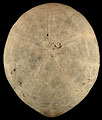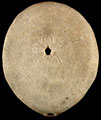|
Diagnostic Features
|
-
Test of small to medium size, elongate, inflated, with deep sides, tapered posterior.
-
Apical system tetrabasal, anterior, with three genital pores (no pore in genital plate 3).
-
Petals slightly developed, flush, equal, often difficult to discern, pores of pore-pairs equal, or outer pore elongated transversely; ambulacral plates beyond petals single pored.
-
Periproct marginal, longitudinal, often with slight groove extending from margin of periproctal opening to lower edge of test.
-
Peristome central to slightly anterior, pentagonal, higher than wide.
-
Bourrelets well developed forming low, projecting mounds.
-
Phyllodes single-pored with two series of pores in each half-ambulacrum.
-
Buccal pores present.
-
Narrow tubercle-free zone both anterior and posterior to the peristome.
|
|
Distribution
|
Late Cretaceous (Maastrichtian) to Miocene of Europe, India and Kazakhstan.
|
| Name gender |
masculine |
| Type |
-
Oolopygus pyriformis (Leske, 1778, p. 255) [=Oolopygus pyriformis d\'Orbigny, 1855, p. 457;=Oolopygus gracilis Lambert, 1909, p. 20]; by subsequent designation of Cotteau in d\'Orbigny, 1854-1860, p. 458.
|
| Species Included |
-
O. pyriformis (Leske, 1778); Maastrichtian, Upper Cretaceous of Europe.
-
O. rostriformis (Kadilnikova & Moskvin, 1984); Early Thanetian, Paleocene of Kazakhstan.
-
O. testudo (Forbes, 1846); Late Maastrichtian, Upper Cretaceous of India.
-
O. crassus (Stoliczka, 1873); Maastrichtian-Danian of Europe, Asia and India.
-
O. jajarunasi (Kadilnikova & Moskvin, 1984); Late Thanetian, Palaeocene of Kazakhstan.
-
O. bajarunasi (Kadilnikova and Moskin, 1984): Thanetian, Kazakhstan.
-
O. rostriformis (Kadilnikova and Moskin, 1984): Late Dano-Montian, Kazakhstan.
|
| Classification and/or Status |
Irregularia; Cassiduloida; Neolampadidae.
|
| Remarks |
The genus name first appears in plates 976 and 977 of Palaeontologie francais, but d'Orbigny had died before a description of the genus and it was Cotteau (1860) that completed the volume and was responsible for the description on p. 446, 454.
Mortensen (1948, p. 160) considered Oolopygus as a subgenus of Catopygus. Oolopygus can be differentiated from Catopygus on the basis of its single-pored phyllodes (double-pored in Catopygus) and the presence of buccal pores (absent in Catopygus), as well as by its three gonopores.
P. M. Kier. 1962. Revision of the cassiduloid echinoids. Smithsonian Miscellaneous Collections, 144 (3) 262 pp.
Jagt, J.W.M. 2000. Late Cretaceous-Early Paleogene echinoderms and the K/T boundary in the southeast Netherlands and northeast Belgium. Part 4. Echinoids. Scripta Geologica 121, 181-375.
d'Orbigny, A. D. 1856 in 1854-60. Paléontologie Française. Terrains Crétacés. Tome 6. Echinodermes, Échinoides irréguliers. 596 pp, pls 801-1006. G. Masson, Paris. 1-32 (July 1854); 33-64 (Oct. 1854); 65-96 (Nov. 1854); 97-128 (Jan. 1855); 129-192 (Mar. 1855); 193-208 (May 1855); 209-224 (Aug. 1855); 225-272 (Nov. 1855); 273-320 (Oct. 1856) pp. 273-352 (Oct. 1856), pp. 353-384 (1857), pp. 385-400 (1858), pp. 401-432 (1858), pp. 433-596 (1860).
|




